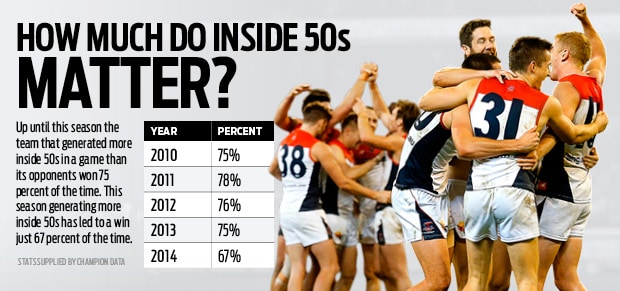EVERY team that won the inside 50 count in round 14 won.
Once upon a time that would not be considered unusual but this season the tide has turned.
Just 67 per cent of games in 2014 have been won by the team that had the most inside 50s.
That is a drop from what was the norm between 2010 and 2013, when at least 75 per cent of games were won by the team that won the inside 50 count.
Round 14 was, in fact, the first round this year where the assumption that the team which wins the inside 50 count wins the game has held.
Of course, three of the past six Grand Finals have been won by teams that lost the inside 50 count, while the Saints forced a draw in 2010 when they had 27 fewer inside 50s against Collingwood.
Some unusual patterns are occurring this season.
Melbourne has not won the inside 50 count in any of its four wins.
Fremantle has lost the inside 50 count three times in the past four weeks yet still won each of its past four games.
Although it would be easy to say both coaches - Paul Roos and Ross Lyon - create strong defensive systems, the explanation would be too simple.
Opposition inefficiency has helped Melbourne win its games.
It defeated four teams hovering on the fringes of the eight - Richmond, Carlton, Essendon and Adelaide – when they could not kick accurately against the Demons.
On the other hand, good teams such as Fremantle are efficient moving forward, kick accurately and therefore spend less time yo-yoing between being inside 50 and in the midfield.
When Fremantle defeated Richmond after losing the inside 50 count 37 to 51, Lyon said the Dockers' count was lower than usual because of their efficiency in attack.
Freo scored 25 times from 37 entries, which Lyon suggested caused its inside 50 to be 10 less than normal because it was denied repeat entries.
Logical, but not a consideration most football fans take into account when looking at the raw numbers.
Most observers suspect more numbers are being dropped further behind the ball and defenders are absorbing pressure deep in defence better than ever. Many clubs are able to limit their opposition's deep inside 50 entries too.
Despite all that, it remains advantageous to win the inside 50 count.
Six of the top eight teams are in the top eight for inside 50 differentials and average time in forward half (Fremantle generates on average 5.8 more inside 50s than its opposition but has spent an equal amount of time in the forward and back half).
The two other teams – Collingwood and North Melbourne – have been forced to defend opposition entries to stay in the eight.
Collingwood has lost four inside 50 counts in its six games since the bye and lost three of those matches, when its defence failed to counter the opposition.
When asked last week, Collingwood coach Nathan Buckley said the Magpies' inability to win clearances had been the biggest cause of the recent inside 50 discrepancy falling in the opposition's favour.
He said the Magpies' defence had held up relatively well under the circumstances. However, at the weekend, the dam wall began to break.
Collingwood is ranked third for preventing scores when its opponents are inside 50, with its rivals scoring just 43.5 per cent of the time after going inside 50. North Melbourne is the most miserly in the competition in that area (41.1 per cent) with West Coast next best (43.3 per cent).
Top four teams Port Adelaide, Hawthorn, the Sydney Swans and Fremantle both generate inside 50s and defend opponents well when they concede them.
That, when it's all said and done, remain the preferred set of numbers for any coach.



